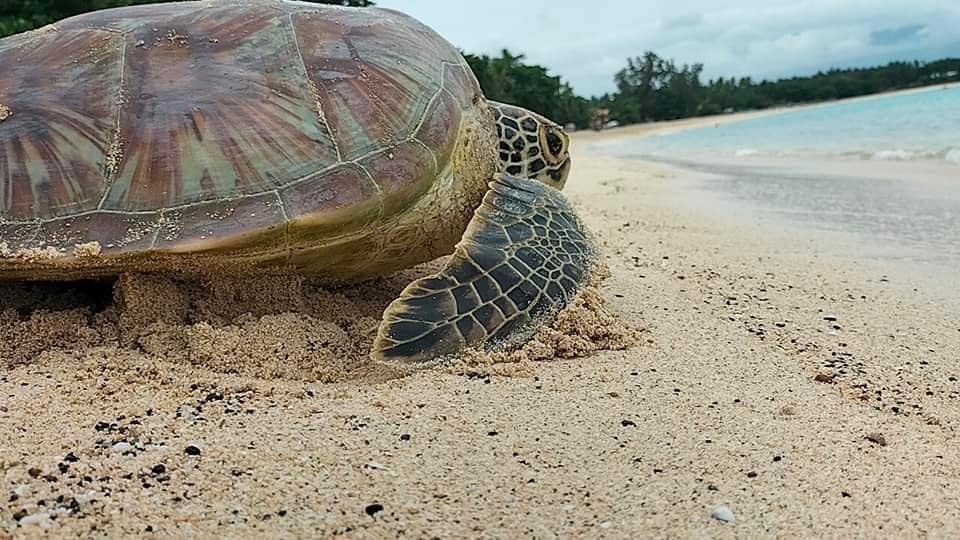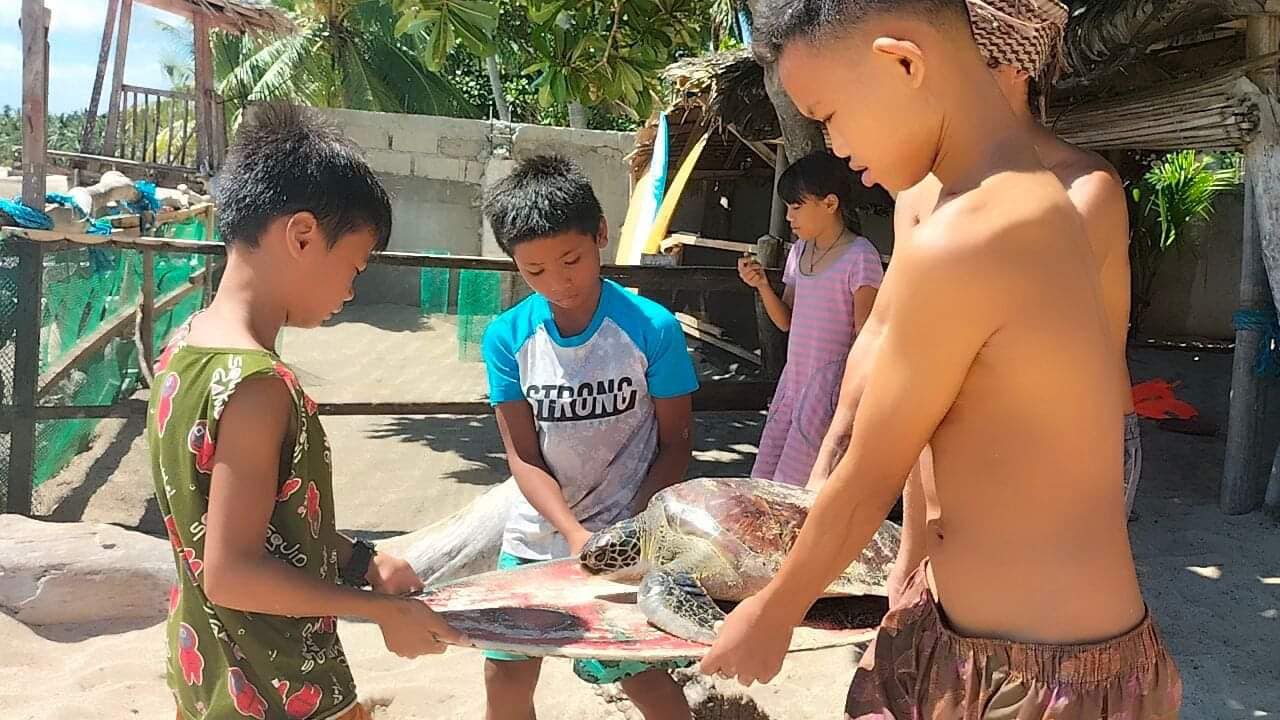Text by Henrylito D. Tacio
Photos courtesy of Winston Plaza
Last October 10, Winston Plaza posted in his social media about a Green Sea turtle that was accidentally caught by a fisherman in the waters of Mati City, Davao Oriental. The fisherman immediately turned over the sea turtle to the Amihan sa Dahican – Save Our Seas located at Dahican Beach. After removing the hook, the sea turtle was safely released to the ocean.
It wasn’t the first time. Last September 28, another Green Sea turtle was rescued in the northern part of Dahican Beach after it was accidentally expelled by a fisherman in the area. It was brought to the same place. After examining that it was already safe, the sea turtle was released again into the open sea.
Dahican Beach, which faces the Pacific Ocean, is known for its waves that are good for skimboarding and surfing. It is also a sea turtle sanctuary with three species nesting in its shorelines. The entire Mayo Bay, of which Dahican Beach is part of, is teeming with several marine species, including whale sharks, dugongs, and dolphins.
“Some members of our team patrol the shorelines of Dahican at night to protect sea turtle eggs from poachers and predators,” Plaza said, adding that they have established two hatcheries for the eggs.
The National Ocean Service (NOS) of the US National Oceanic and Atmospheric Administration says it takes 20-30 years for a sea turtle to reach sexual maturity. When a female is ready to lay eggs, she returns to the nesting beach where she was born, even if she has not been there for 30 years! Some females next every year until the age of 80.
Marine biologists say sea turtle eggs must incubate in moist sand. It is for this reason why some beaches around the tropical and temperate areas are visited, mostly at night, by adult sea turtles who come ashore to dig a nest chamber, where they deposit their eggs.
Once the eggs are deposited, the female sea turtle just leaves the eggs to fend for themselves. Hatching can take one day to four days for the baby turtles to break through the eggshell and emerge from the egg. Once they are fully out from the eggshells, they are ready for release, usually within 24 hours.
For every 1,000 hatchlings released in the open sea, only one survives. “On the beach, hatchlings must escape natural predators like birds and crabs to make it to the sea,” NOS says. “Once in the water, hatchlings are consumed by seabirds and fish.”
Sea turtles are the contemporaries of the dinosaurs. These ancient creatures have been around for about 110 million years. Their natural lifespan is estimated to be from 50 to 100 years.
Sea turtles are locally called pawikan, and it is different from pagong. While they may look quite similar, and both are reptiles, they are actually different. In English, pagong is called tortoise. Pawikan has four flippers while pagong has four legs.
Although they are called sea turtles, they cannot breathe underwater. Their secret is breathing for long periods of time – between 4 to 7 hours when resting. While holding their breath, their heart rate slows significantly to conserve oxygen – up to nine minutes can pass between heartbeats, according to Smithsonian Ocean.
Sea turtles have played vital roles in maintaining the health of the world’s oceans for more than 100 million years, Oceana points out. They help sustain the health of seagrass beds and coral reefs that benefit commercially valuable species such as shrimps, lobsters, and tuna.
“Seagrass, where fish, shellfish, and crustaceans live, needs to be ‘mowed’ by sea turtles in order to grow properly,” states Marine Life Organization. When Green Sea turtles regularly graze on seagrass, for instance, the blades gain more nutrients and can thrive rather than become overgrown and end up decomposing.
Because they undergo long migrations, they also provide habitat for an array of “aquatic hitchhikers” like barnacles and other small crustaceans, remoras, algae, and diatoms. They also act as sort of an umbrella for fish that use them as shelter from predators.


There are seven sea turtles known to man, and five of them could be found in the Philippines. Aside from Green Sea turtles, the other species swimming in the country’s waters are Hawksbill, Olive Ridley, Loggerhead, and Leatherback turtles.
Nearly all species of sea turtles are now on the verge of extinction. Under the International Union for Conservation of Nature (IUCN), Green Sea and Loggerhead turtles are classified as endangered species, while Olive Ridley and Leatherback turtles are categorized as vulnerable. Hawksbill turtles are considered critically-endangered or in a high risk of facing extinction.
The greatest threats to sea turtles are not from natural predators but from humans and their destructive activities. “Accidental catches in commercial fisheries or entanglement in marine debris are serious threats to sea turtles, as well as destruction of beach habitat, harvesting or poaching for meat and eggs, and even boat strikes,” NOAA said.
In the Philippines, sea turtles are conserved and protected through the provision of Republic Act No. 9147 or “Wildlife Resources Conservation and Protection Act.” Exploiting, inflicting injury, hunting, or trading or killing them are punishable by law, including imprisonment of at least six years and a fine of up to one million pesos.
To save them from further decimation, the Aboitiz Group through the Davao Light and Power Company has set up the Marine Turtle Sanctuary in its Cleanergy Park in Punta Dumalag in Matina Aplaya. The site is part of the 37-hectare marine protected area that was established through Council Resolution No. 02504-03, declaring the area as a nesting ground for Hawksbill turtles.
“Davao City is truly blessed to be a nesting site of sea turtles, which is a keystone species in maintaining the balance in our ecosystem. It is clear that the government and the private sector must work together to protect these endangered animals before it becomes too late,” said then city mayor Sara Duterte-Carpio after signing the Memorandum of Agreement between Aboitiz and the Department of Environment and Natural Resources and the city government in the establishment of the Pawikan Sanctuary.
The Cleanergy Park has a temporary shelter, clinic, laboratory, observation deck, boardwalks, and other facilities for the rescue, rehabilitation, conservation, protection, and care of sea turtles. This supports the multi-sectoral effort of “pursuing sustainable development within the context of a balanced ecology.”

